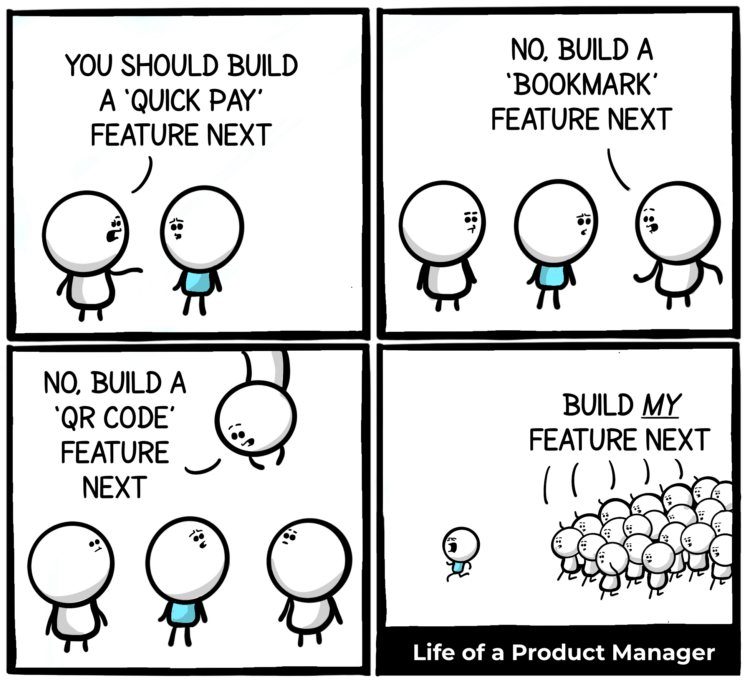ProductFTW #7: Building Confidence in Saying "No"
This week, I want to dig a little deeper into a topic Ellen touched on in our last post: the product management mantra that you should say “no” more than you say “yes.” It was certainly the first big lesson Matthew instilled when he hired me as a product manager at Wallaby–which felt especially uncomfortable for me at the time because it was my first time in a PM role. I didn’t feel like an expert in anything yet, and I had built my early career and reputation by saying “yes.”
There are countless posts about the importance of saying “no” and tips on how to do it more confidently (on which I’ll also give my two cents below), but I think what many people miss in the conversation is helping those of us in product roles turn inward and first talk about why it's so hard and how confronting it can be so that we can build our confidence and this skill more holistically.

Why can it be difficult to say “no”?
- Fear of conflict: As product managers, we work at the intersection of various stakeholders horizontally across functional teams and vertically through many levels of the organization. We often have to lead through influence and relationships, so saying “no” can and likely will lead to conflict at times, which can feel scary, destabilizing, and potentially damaging to the relationships we rely on. In general, addressing any fear of conflict you may struggle with is an important part of being a strong product manager and leader.
- Managing our professional image and expectations: Product managers are often facilitators of progress and enablers of ideas. Saying “no” can sometimes be perceived as being unhelpful, obstructive, or negative and create some cognitive dissonance when we want to be seen as a cooperative and supportive colleague. In our role, we are often measured by our ability to deliver, and “no” can feel like the opposite of delivery. Always saying “yes,” though, comes with the same risks if you can’t actually deliver on your commitments.
- FOMO: In the often fast-paced startup environment, saying “no” to a feature or project might mean missing out on a potentially successful outcome. We work to build a product vision, to prioritize and be strategic, and there may still be the fear that the vision, priority, or strategy could be missing something that could lead to our product’s big moment.
- Pressure to perform: The role of a product manager often comes with high expectations for success and innovation, and with that, a feeling of pressure to perform and please all stakeholders, making it challenging to say “no,” especially if it’s a feature or initiative being pushed by influential team members or leaders. You will never be able to please every single stakeholder and team member, and that’s ok.
- Optimism bias: As with any unconscious bias, we can all be susceptible to their impacts when we aren’t doing work to confront them. There’s an amount of optimism everyone needs to work in a startup, especially when we are in the 0 to 1 phase of the business, perhaps as the first product hire in your company, but there’s a point that it can go too far and lead us into overcommitment.

You can’t outrun “no”
In my own experiences, there were certainly projects and times when I should have said “no,” but because of the pressure I felt (external or internal) or that optimism bias sneaking in, what I learned from those is that while saying “yes” upfront may have felt easier, they always caught up to me. Whether it was having to push a launch date or cut features, saying “yes” when I shouldn’t have only delayed having to experience the same feelings I was trying to avoid. Those feelings were then also paired with me having to take ownership of the fact that we were behind or overcommitted.
Building your “no” confidence
A few insights and things to keep in mind that I think are helpful when trying to get more comfortable in saying “no”:
- Focus is key: Resources are finite, particularly in startups, and one of our most important jobs as product managers is to drive focus on our teams. Saying “no” helps focus your often limited resources effectively, ensuring that you’re working on what truly matters and can deliver on your commitments. Keeping this in mind can help build your confidence and also help you communicate across the organization why you’re making trade-offs or saying “no” to something.
- Clarity leads to credibility: Initially, in my own career, I worried about the repercussions of saying “no,” particularly to leaders and executives who were often the founders and original product managers for the products on which I was working. However, clarity in decision-making builds your credibility and trust with your leadership team by demonstrating that you have well-thought-out strategies and understand the needs of your customers and the business.
- Prioritization takes courage: Again, saying “yes” can seem like the path of least resistance, so saying “no” requires courage to make very tough decisions for the greater good of the product or team. The way that you build courage is by acknowledging the things that might feel scary and making the conscious choice to face them, building the muscles and resilience to do hard things more easily and more comfortably each time you do them.
- Not right now doesn’t mean never: It's important to remember that “no” is often temporary. Prioritization is about timing and relevance, balancing the short-term needs, time, or constraints with the capacity of your team and what’s going to deliver the most value to the business goals. This is part of why you keep a backlog so that you can say “yes” to ideas when they better align with your strategy. Reminding the team or stakeholders of this can also help you when you deliver a “no” that they might not want to hear.
- Remember to have empathy: Product management calls for empathy in many things and for many people simultaneously - your customers, your team, and your stakeholders. Understand and acknowledge the merit in the feature you’re declining and explain your rationale so that leaders or teams that are impacted by your decision understand why your “no” is important. Empathy, coupled with some of the tips that Ellen covered last week about effectively communicating, like being direct, documenting your decision-making, and practicing, can go a long way in building credibility and rapport even when delivering hard news.
Embracing "no" isn't about shutting down ideas; it's about sharpening your focus on the projects that truly resonate with your goals and driving value for your customers and the business. It's a skill that's rooted in bravery and a clear-eyed view of your priorities. If there's one thing my journey has taught me, it's that every "no" makes room for a "yes" that can genuinely make a difference. So, I'm curious—how have you tackled the art of saying "no" in your role? Were there things that made it hard for you at times, and how did you overcome them? We’d love to hear any stories or tips you're willing to share in the comments.
